This mini Chocolate Pâte Sablée tart crust is a delicious, buttery shortcrust, melt-in-the-mouth pastry shell that turns desserts into fancy French patisserie-like tartlets. This chocolate tart case is the perfect base for a great variety of fillings! You might refer to this kind of pastry as shortcrust, sweet short pastry, sweet-tart crust, or simply a mini tart shell.

Jump to:
What is a tart / tartlet
A tart is a freestanding, shallow, open-faced pastry consisting of a filling in a pastry case with an open-top, not covered with pastry. The pastry is usually a rich shortcrust pastry (Pate sable dough), while the filling can be both sweet or savory. A tart case is typically baked in a tart ring with fluted or straight sides. Smaller mini tarts are often referred to as tartlets. Lemon tart, fruit tart, chocolate tart, coffee tart, caramel tart...you name it!
Tarts and tartlets are some of the most popular pastries all around the world. As fancy as they look, these French pastries are in fact surprisingly easy to make at home and can be the most impressive desserts on any family or friend get-together.
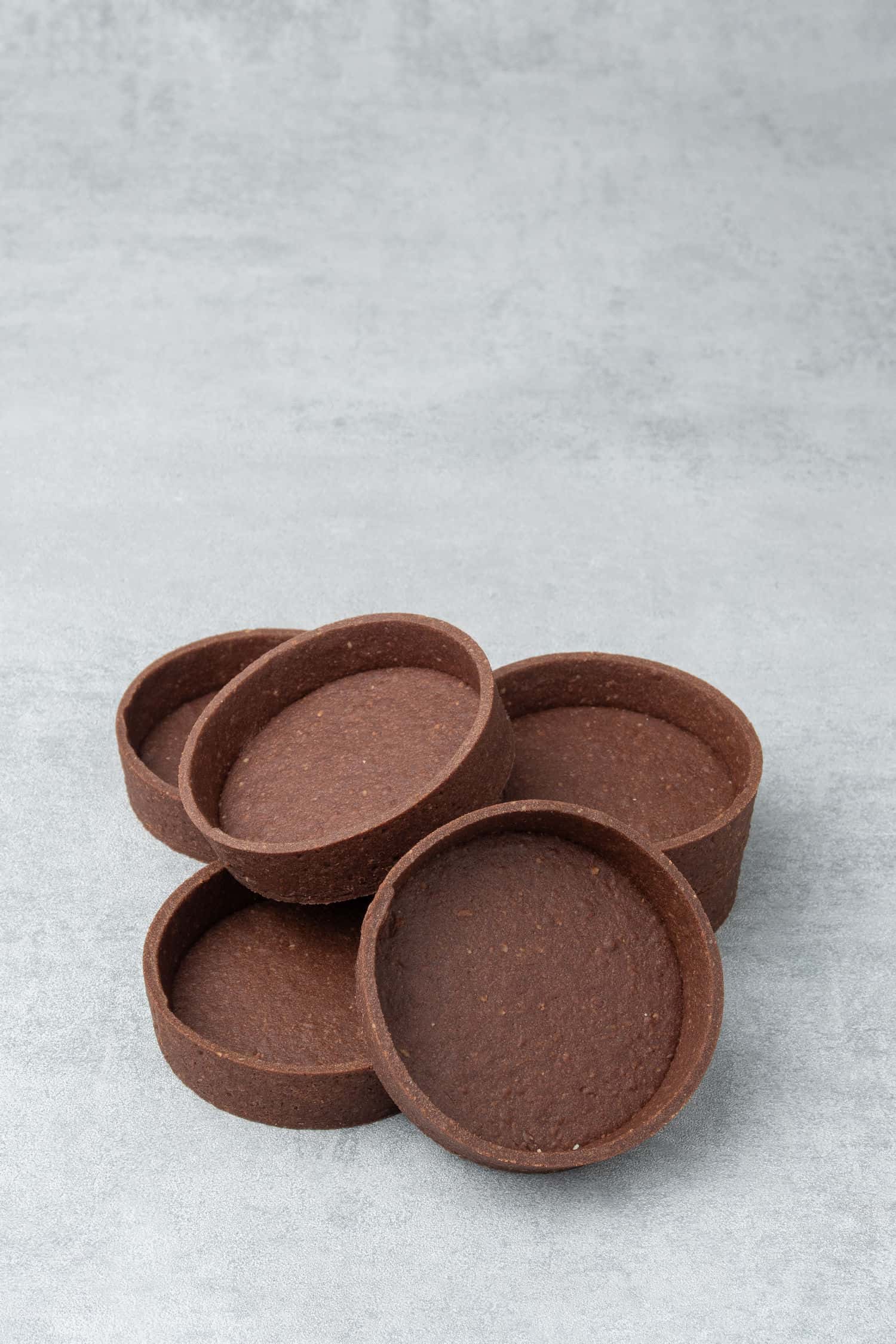
What is Pâte Sablée
Pâte Sablée is a classic sweet shortcrust pastry dough that is used to make delicious French tarts, such as Fruit tart eg. Strawberry tart, Lemon tart, or Chocolate and Salted Caramel tart, etc.
Unlike traditional American flaky pie crust, this Pate sablee makes a crispier and more biscuit-like chocolate tart shell. It is super delicious, buttery shortcrust that is sweet but not too sweet, a melt-in-the-mouth pastry dough. The sable pastry recipe contains only a few basic ingredients - like butter, sugar, and flour - yet can be the base of the fanciest, most amazing desserts you will ever make. Once you learn the basics of preparing these mini pastry cases, it will be possible to play around with the ingredients and eg. replace some part of the flour with hazelnut flour to make Hazelnut tart, or even add in some special ingredients like this Black sesame tart.
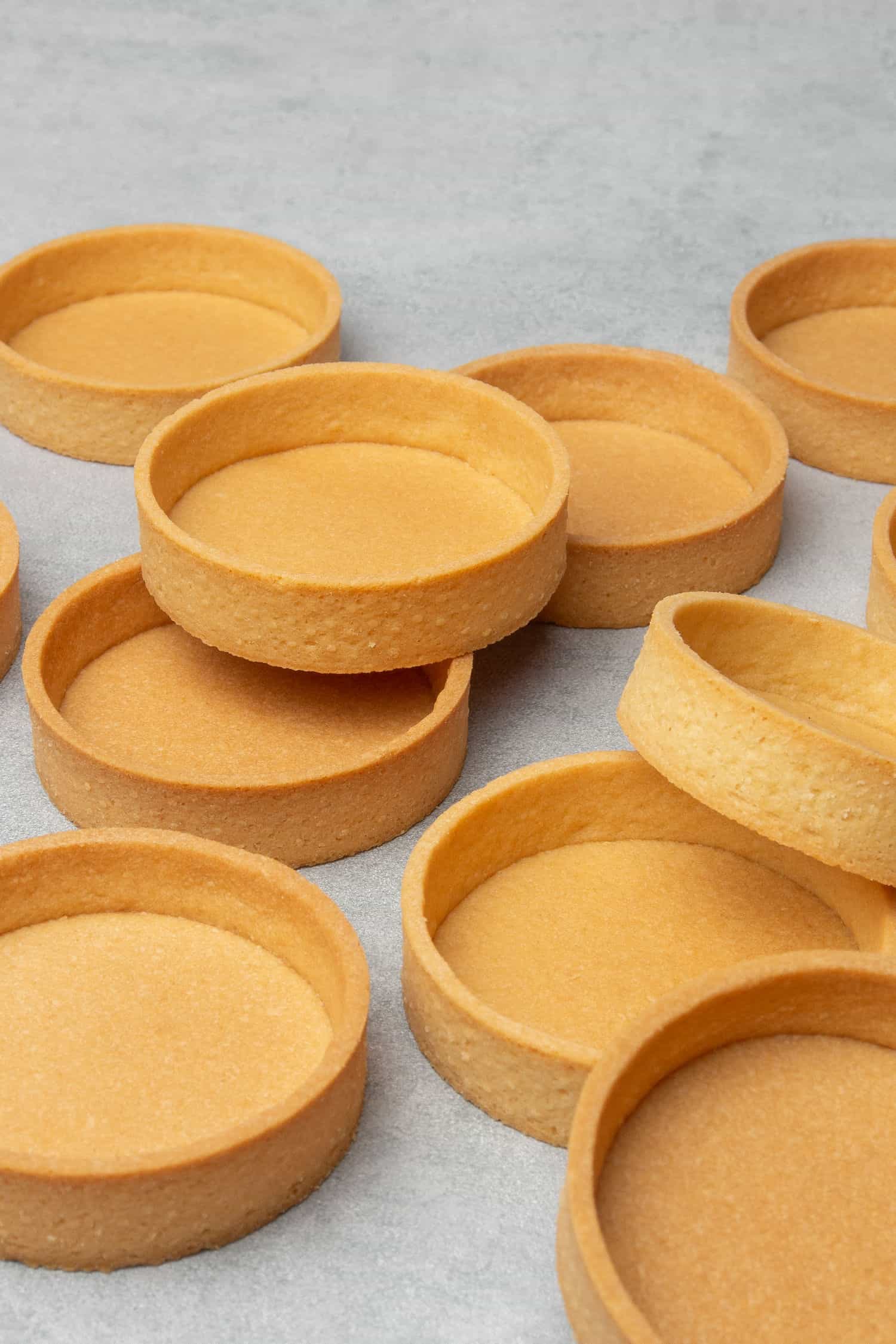
Why this is the best recipe
This is a professional mini Chocolate Pâte Sablée tart case recipe that is adopted to home kitchen environment eg. several chilling times are involved to keep the pastry on the right temperature to work with.
The most important factors to bake neat, professional-looking Pâte Sablée tart cases are:
- Using the right ingredients on the right temperature eg. 82% fat content European style high quality unsalted butter used chilled
- Using the right equipment, eg. perforated tart rings that ensure even baking without blind baking
- Learning the right technique, eg. how to roll the pastry to an even thickness
In this sable pastry recipe - whether you make mini tartlets or full-size tarts - I cover all the necessary information you probably haven´t read anywhere else, so your tart cases will turn out exactly like mine!
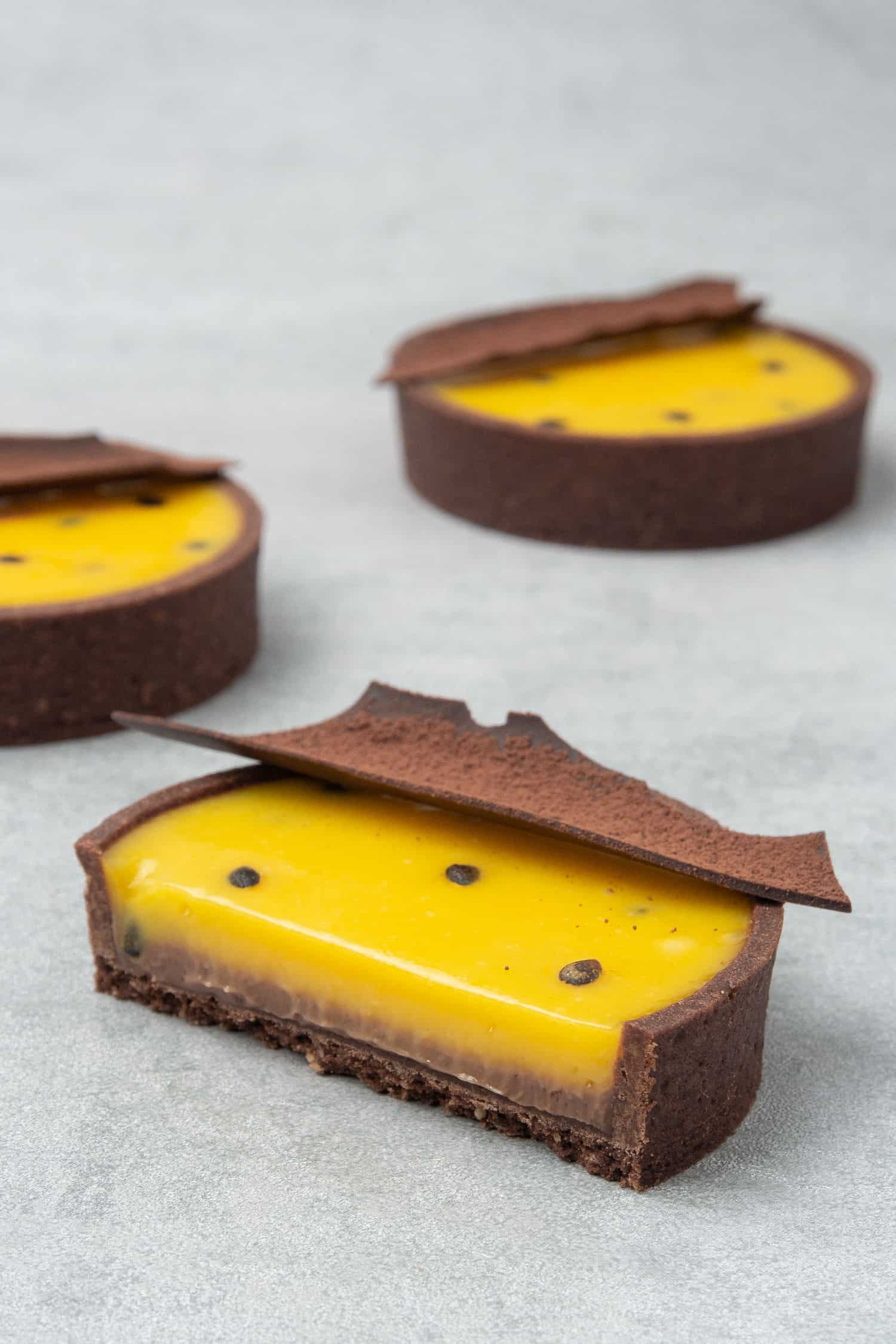
Ingredient notes
- Flour: I am using pastry flour (that is lower in protein content) for this French tart shell recipe, feel free to use All-purpose flour, if can't find pastry flour in your local supermarket. If you want to be a Pro when it comes to deciding what type of flour to use in your baking, please read my article here
- Almond: Some Pâte Sablée recipes contain almond, some don't, I prefer mine with almond flour from a taste and texture point of view. Pâte Sablée with almond flour is slightly crispier with some marzipan taste. It is worth buying good quality ground almonds, without skin. Almond can be replaced with hazelnut, walnut, pistachio flour too, or alternatively, in case of nut allergy, replace it with an equal amount of pastry flour
- Cocoa powder: The cocoa powder will make this recipe into a wonderful Chocolate tart case! Always use unsweetened, 100% cocoa powder in baking. I use dutch-process cocoa powder, it has a lovely dark color and it is lower in acidity
- Sugar: This sweet shortcrust pastry is made with a small amount of icing sugar that makes the tart case sweet but not overly sweet. If you want to learn about the different types of sugar and how to use them in baking, please read my article here
- Salt: An essential ingredient in most dessert recipes. Balances flavor and enhances other ingredients. This is a sweet-tart dough and I just love that extra very mild salty kick at the end
- Butter: Use always unsalted as you want to be in control of the quantity of the salt. I am using high-quality 82% fat content European-style butter in all my recipes. While in most of the recipes butter needs to be at room temperature, this is an exception and you have to take it very seriously. The butter needs to be chilled, which means take the butter out of the fridge, cut it into cubes then place it into the freezer for 10-15 minutes before using it
- Egg: Room temperature as always. Please note that this is not a Vegan pâte sablée recipe and the egg can´t be left out or replaced unless you have the knowledge to totally reformulate the recipe
Exact ingredient quantities can be found in the RECIPE CARD, at the bottom of this page.
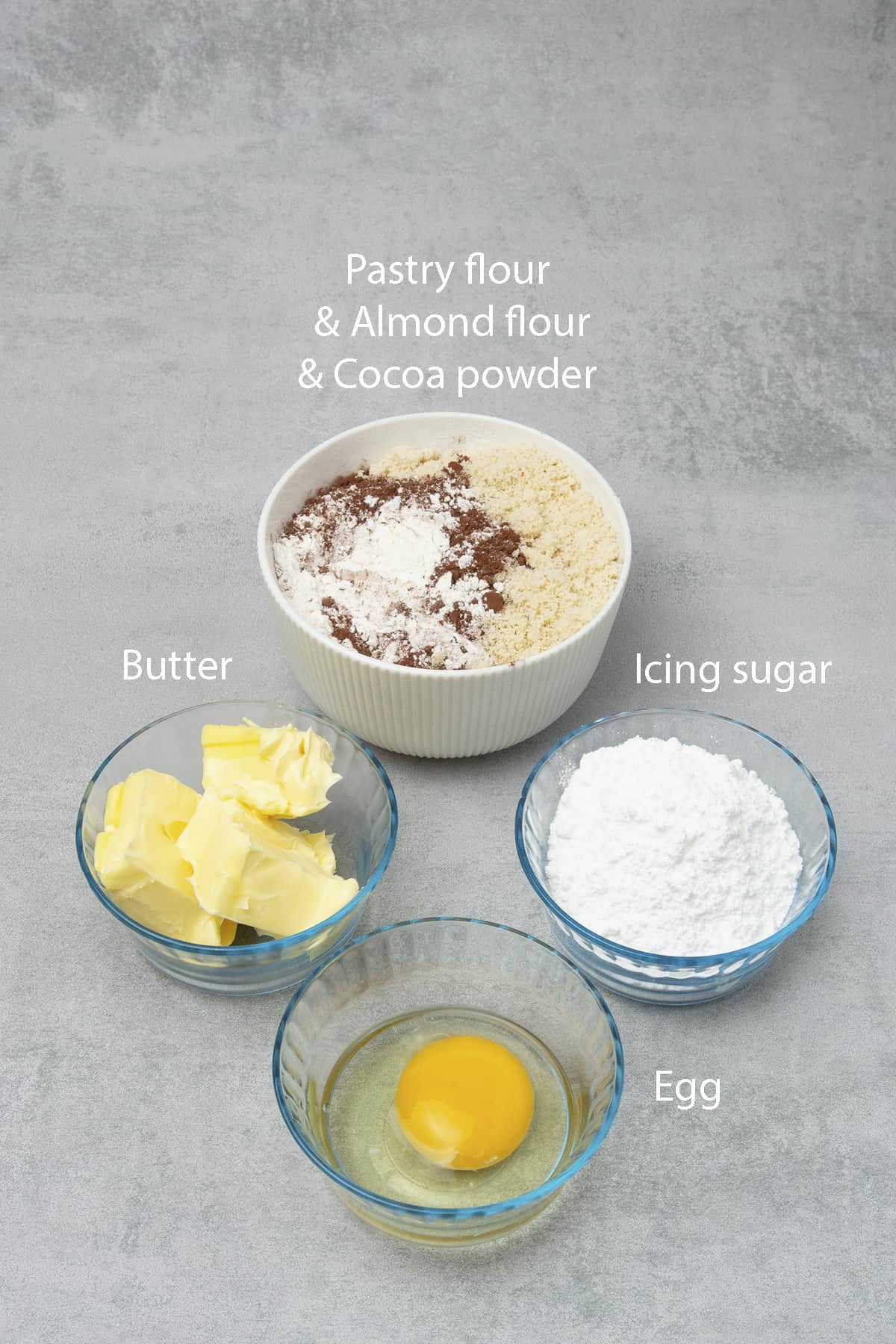
5 Expert tips
1. Creaming vs. Crumbling method
There are 2 main methods in the pastry chefs' world making Patee sable tart shells; one is creaming, the other is crumbling. With the creaming method, the butter is at room temperature, and first needs to be creamed with icing sugar, then you mix in the rest of the ingredients.
In the case of the crumbling method, first, you mix the dry ingredients (flour, almond flour, salt), then add in very cold butter in cubes. Then, you need to rub the mixture between your hands until it becomes a "crumbly" = sand-like consistency before adding in egg.
I am sharing the crumbling method with you in this Chocolate tart recipe, which is my preference for one single reason; as the butter used while it's very cold, overall it makes the sweet shortcrust pastry dough cooler, meaning easier to work with. And that brings us to the next important topic, the temperature. Either way, no need to use a food processor, the actual kneading process is made with your hands in literally 1-2 minutes.

2. The importance of temperature while making Chocolate tartlet
When I started experimenting with baking, I had several disastrous attempts making Pate sablee. Now I understand that the one and only reason I failed was being impatient and forcing the dough even when its temperature was inappropriate.
Baking is science and in general, temperature is one of the most important factors to understand and utilize for our benefit. When I say temperature I don't purely mean baking temperature, but also the environment we work e.g kitchen temperature as well as the dough temperature.
While making this mini chocolate tart case recipe, the temperature is everything! If the dough is too warm, it's sticky and can't be rolled out or shaped. If too cold, it will easily break. The entire pastry-making process is a balancing exercise between keeping the dough cold enough, but not too cold.
To give you a concrete example, in a home kitchen environment on a warmer day this practically means taking the dough in and out of the freezer about 10 times in between steps to ensure the dough is always on the right temperature to work with.
If you are lucky and have a cold kitchen, you might be ok with 2-5 chilling breaks. Yes, not just to chill the dough once or twice but to be in control of the dough temperature at all times! Obviously in professional kitchens temperature as well as humidity is under control, and the rolling process is done by a laminator machine, however in a home environment remember, this is something we have to be super careful with.

3. What is blind baking and how to avoid it
Baking blind is the process of baking a pie or tart crust without the filling. It's done by lining the tart tin with parchment paper and filling it with eg. pie weights. Frankly, it is not an ideal, professional solution, and while it certainly prevents the crust from puffing up while it bakes, it does not provide even baking. Blind making makes the tart crust somewhat unappealing, full of wrinkles as I call it, and baked unevenly.
My Chocolate Pate sable recipe DOES NOT involve blind baking, instead, I am suggesting using perforated baking rings and a perforated baking mat for the best results. The recipe, of course, can be made using the traditional blind baking method with pie weights, however, I recommend working with perforated equipment for a neat-looking result. Please see below my Equipment tips for further details.
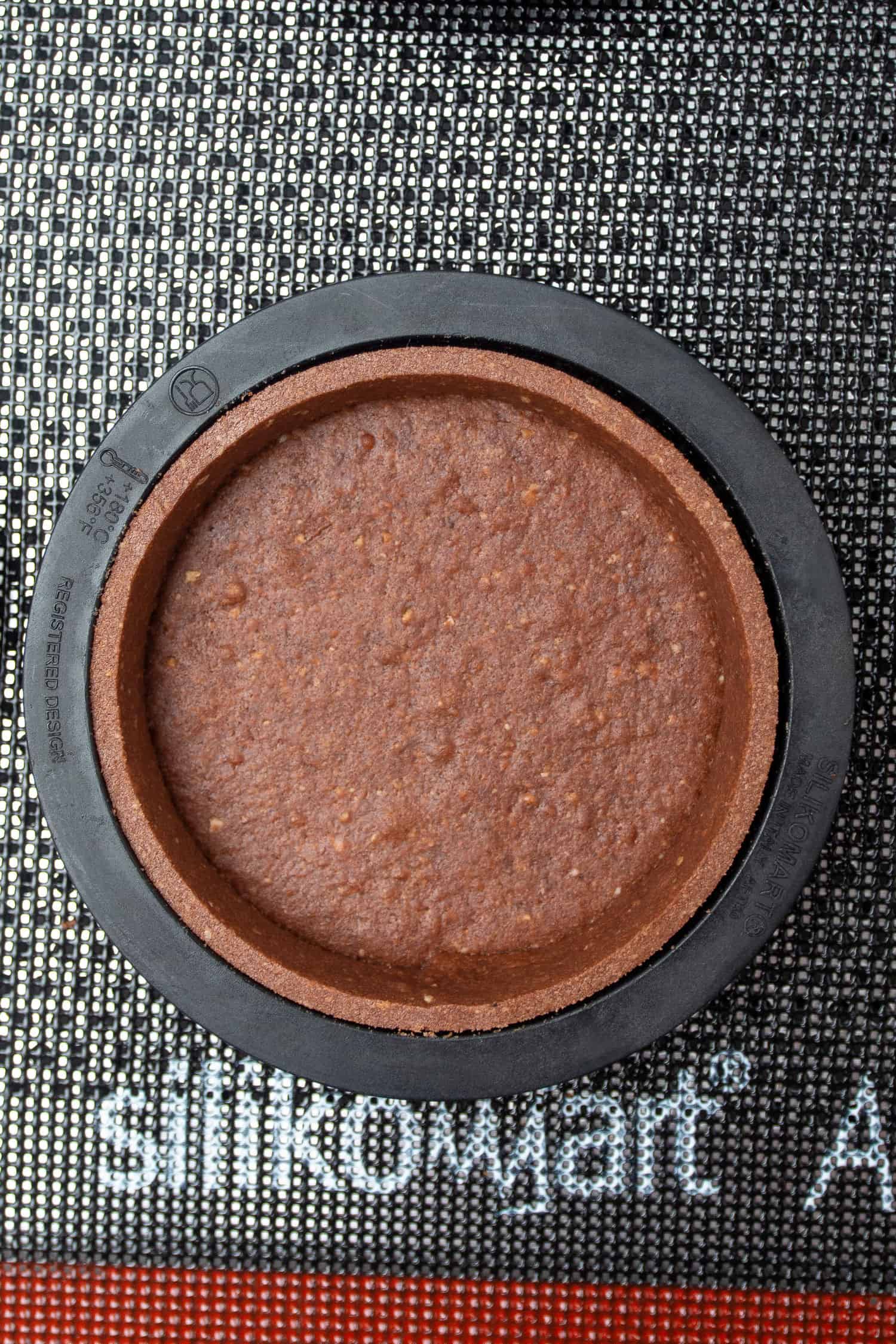
4. How to avoid the chocolate pastry dough shrinking while baking
Have you ever experienced a shrinking, sad-looking pastry while baking? Never again! 3 things to remember: temperature, technique, and equipment.
In terms of temperature, you have to freeze the shortcrust dough before baking as that will ensure that the dough keeps its shape while baking. Also, make sure your oven temp is correct, highly recommended to use a Digital oven thermometer.
In regards to technique, you must not force the dough while placing it into the tart pan. First, cut the bottoms out with the help of the actual tart ring, then cut out some long strips - this will be the side of the mini chocolate tart shell. The pastry dough should be carefully but firmly pressed onto the side of the Perforated tart ring so it won´t fall while baking. If it does (it should not), quickly open the oven door and press it back with your finger.
Last but not least, use the right equipment; while using Perforated tart ring, the dough somewhat sticks to the side of the ring as opposed to shrinking like in the case of non-perforated rings. Once you try this equipment, you will never bake pastry without it, I can guarantee!
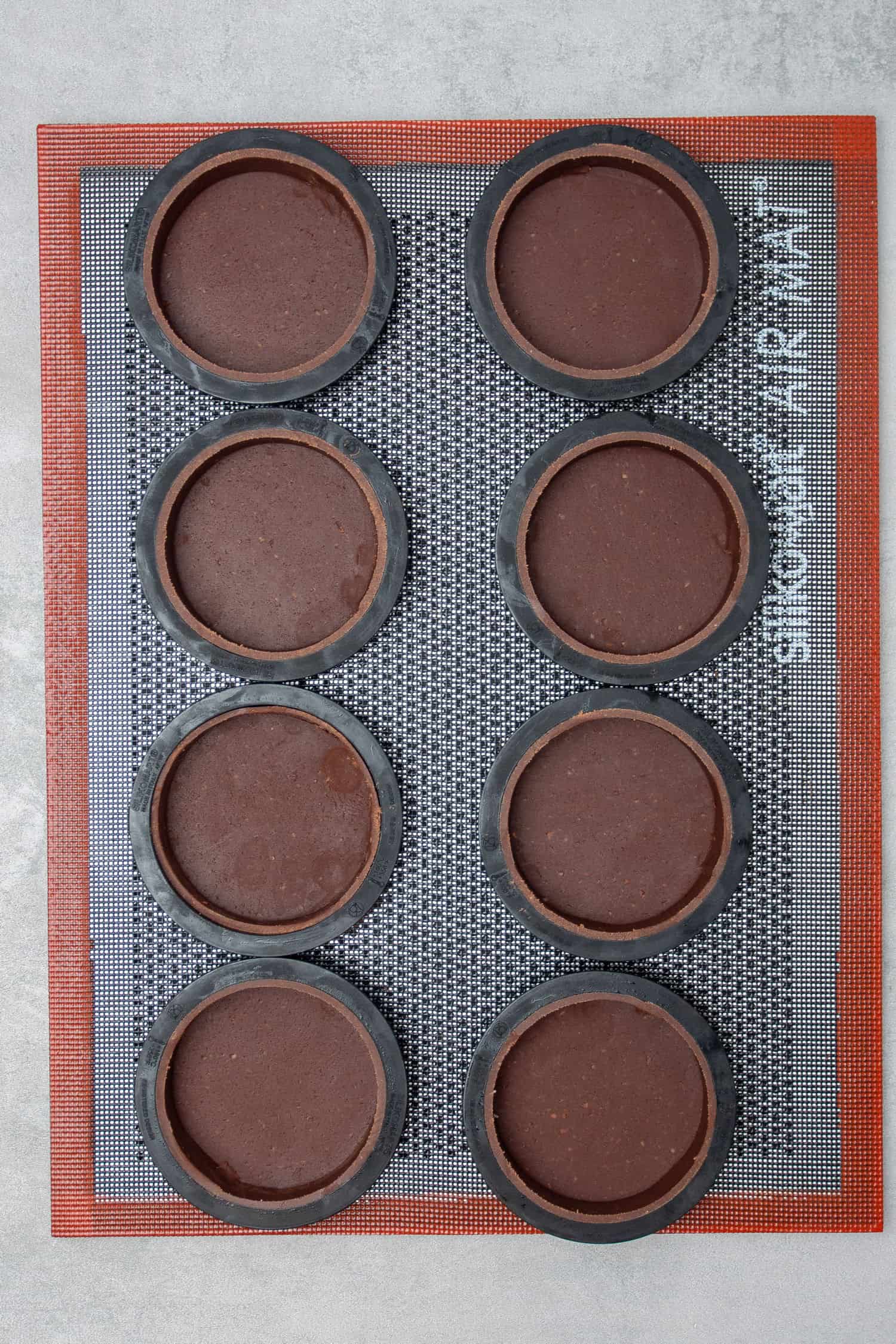
5. Process of making a Chocolate tart dough
Now that we covered all the important WHAT and WHY, let´s see how exactly to make sweet shortcrust pastry for your favorite tartlets!
- Measure all ingredients with a Digital scale and prepare all the equipment ahead: Rolling pin, Silicone baking mat, Perforated “air” baking mat, Perforated tart ring
- Place the measured butter chunks into the freezer for 5-10 minutes
- Sift together the dry ingredients; flour, icing sugar, cocoa powder, almond, salt, and mix so they are combined properly
- Add very cold butter chunks into dry ingredients and rub the mixture between your hands until it becomes a sand-like consistency. This will take about 2 minutes, make sure you do not spend too much time with this step as butter can easily warm up, and that is something we want to avoid. Please note that there is no need to use a food processor!
- Add egg into the mixture and mix with your hands just until the dough comes together. First, it might look crumbly but do not add more wet or dry ingredients to the recipe instead gently knead the dough with the palm of your hand for a minute or two (do not over-knead and do not use a mixer) just until the dough becomes smooth
- If the dough is too warm and sticky, place it into the fridge for 10-15 minutes first. Otherwise, continue with rolling the dough out into 2mm thickness between two Silicone baking mat. The recipe quantity is designed in a way that once you roll the dough out, it will reach the silicone baking mat from edge to edge (11.6 inches / 30 cm x 16.5 inches / 42cm)
- Place the chocolate tart dough into the freezer for 10-15 min in between the two Silicone baking mat. Do not remove the mat at this point as the dough might stick to the mat while it is warm
- Prepare your oven rack with the Perforated "air" baking mat and Perforated tart rings on top
- Take the dough sheet out from the freezer, remove the top of the silicone mat, and using one of the Perforated tart rings, cut out 8 circles – this will be the bottom of your tart crust. Carefully move the dough circles with the help of an Offset spatula and place them into the rings one by one
- If at any point the chocolate pastry dough gets too warm to work with, pop it back into the freezer for 5 minutes. You might need to take the dough in and out of the freezer a lot of times but that is fine, don´t try to force the dough while it is warm. It is extremely important to work with a dough that is cold enough to be able to handle (so not sticky) but not too cold which would result in breaking it
- Cut 8 long stripes out of the dough, this will be the side of the tart
- Carefully place the stripes into the ring one by one. Press each strip onto the side of the ring so it sticks to it. Again, make sure you work with a dough that is cold enough but not frozen as that would make it impossible to place it into the tart pan without breaking it
- Place the Perforated tart rings with the chocolate pastry dough in them into the freezer for 1 hour
- Pre-heat oven to 160C / 320F
- After 1 hour, take the sweet shortcrust pastry dough with the rings on them out and trim the top with a sharp knife
- Bake them for 20 min then carefully remove the rings. Once you take the chocolate tarts out of the oven wait for a minute or two for the pastry to somewhat contract within the ring then you will be able to easily remove the rings. If the pastry seems to be stuck onto the ring, it means probably you will need to bake it for a few more minutes. Do not force it as you can easily break it
- Once tart rings are removed, you will need to place the tart cases back to the oven. Bake them for another approx. 10 minutes, adjust the baking time if needed. Rotate the baking sheet, if necessary. Let them cool on the Perforated "air" baking mat before filling them
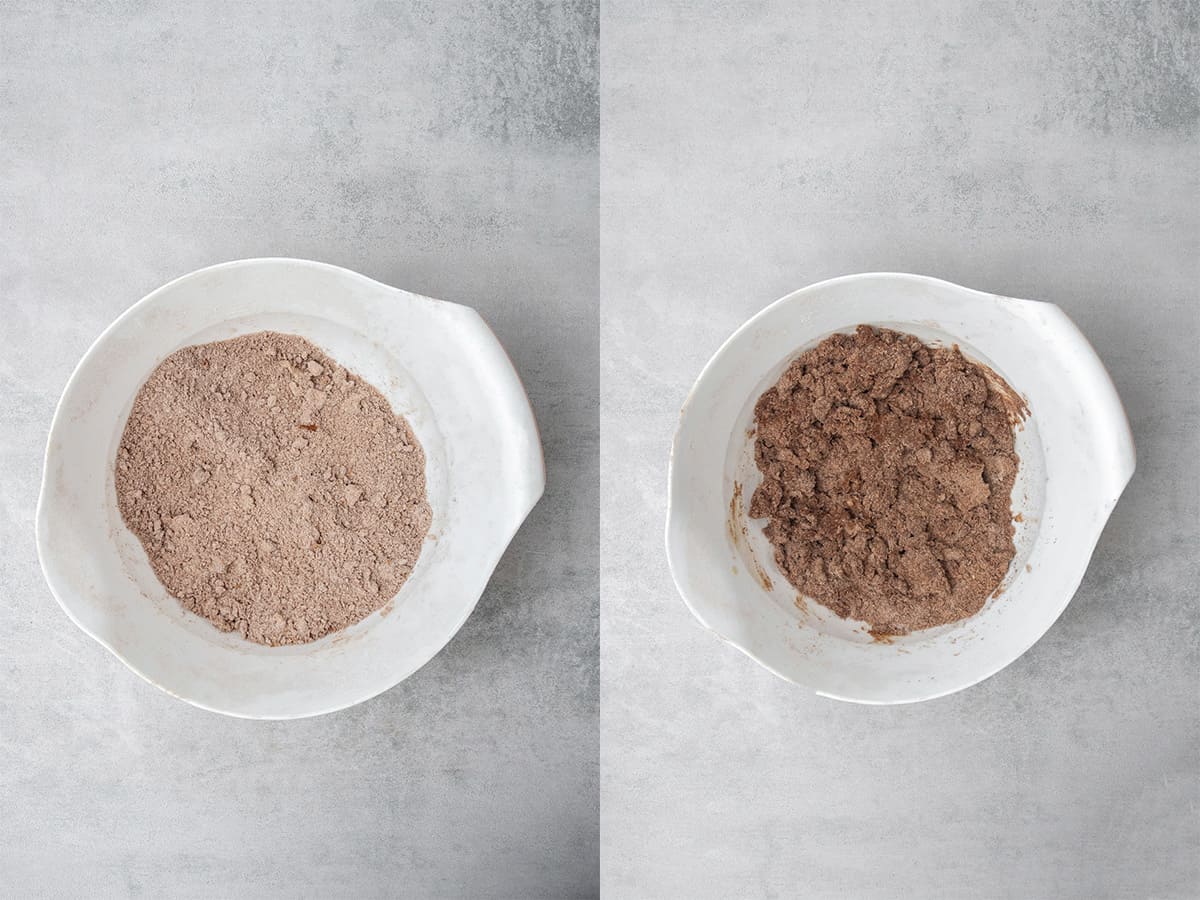


Equipment notes
You can achieve neat, visually appealing, professional-looking chocolate tart crust by using professional baking equipment. Luckily these are available to purchase on Amazon not just for professionals, but also for home bakers.
Silicone baking mat
I recommend using 2 Silicone baking mat for rolling the pastry dough out in between them. The recipe is designed in a way that you do not need to add extra flour while rolling the dough however it might stick to your kitchen counter so use a silicone baking mat. It’s also possible to use 2 sheets of parchment paper however the silicone mat provides a much neater, smooth surface. It can be washed and re-used all the time so overall worth the investment. I am using the “Amazon basics” cheapest version, no need to buy anything expensive.
While rolling, start from the center of the disc and work your way out in all directions. Again remember, the temperature is very important. If the dough is too cold, you won´t be able to roll it out. If too warm, it will be difficult to handle and will even stick to the silicone baking mat. Use your fridge or freezer to control the temperature of the pastry dough at all times.

Perforated baking “air” mat
The Perforated “air” baking mat is perfect for making tart crust, éclairs, or even cookies. Thanks to the holes in the mat, the heat spreads evenly throughout mats’ surface guaranteeing a perfect and even baking without blind baking. The dough won´t puff up while baking the tarts and will be baked super neat.
While baking the mini chocolate tart shells, use the Perforated “air” baking mat straight on top of the oven rack (so not in a baking pan) so that the air can circulate properly. I have been using Perforated “air” baking mat for years from a brand called Silikomart and love it!
Perforated tart ring
The Perforated tart rings are non-stick and stainless, they allow homogeneous baking due to the even air circulation. Silikomart offers rings in various shapes and sizes, I am using an 8cm (3,14inch) diameter round version in this case, however, the recipe can be made in larger rings as well just like this Raspberry Frangipane tart. As far as I can see there are several cheap copies of the initial Silikomart product, I am not sure though whether they are made of the same material and whether they work or not.
Absolutely no need to grease the tart rings when making Pâte Sablée, the dough will stick to its perforated side while baking, and will contract after baked - so the ring can be removed easily. These Perforated tart rings are the best investment I have ever made!

Recipe FAQs
Yes, you can use traditional equipment (eg. tart pan) and technique (eg. bling baking), however, for the best results I can warmly recommend investing in a couple of tart rings and a perforated baking mat
Yes, in fact, I have a Classic Pâte Sablée recipe too, check it out!
Yes of course you can, this recipe works no matter what size or shape of tarts you want to bake, however, you will need to adjust the baking time accordingly, as well as maybe double the recipe ingredients depending on how many you want to bake.
Yes, most probably you can, I am working on a gluten-free version myself, however, you can´t just replace flour with gluten-free flour 1:1 without reformulating the recipe. When one ingredient changes, some other ingredients need to be changed too in order to keep the balance in the texture and flavor
Probably you can, however just as making it gluten-free, you will need to adjust the ingredients somewhat if the egg is left out. Sadly, I am not able to provide substitutes for all sorts of allergies and diets
Before you fill the chocolate tart cases, you can store them easily on top of each other in an air-tight container. Once you fill them, they should be served soon as depending on the type of filling you use they might get soggy after a day or two. Any leftover can be stored in the fridge. Cover it, so it does not absorb any smell from the fridge
You can easily freeze the tart cases before baking, and bake them fresh when needed. Once they are baked, you can still freeze them, however, they might lose the crispiness a bit. Once filled with cream, I do not recommend freezing them but serving them shortly after (depending on the filling)
Fillings ideas
Passion fruit & Chocolate tart – If you have not tried pairing passion fruit and chocolate before, you are missing out, they are truly match-made in heaven! Silky & rich chocolate ganache meets floral & tropical yet tangy passion fruit curd in this Chocolate Pâte Sablée tart shell!
Salted caramel & Chocolate tart – This Salted caramel chocolate tart is one of my favorite tarts ever! It just tastes phenomenal as the buttery caramel with a slightly salty kick meets the silky chocolate ganache!
Chocolate & Raspberry tart - Silky & rich chocolate ganache meets wonderful raspberry mousse in this French Chocolate Raspberry tart recipe!

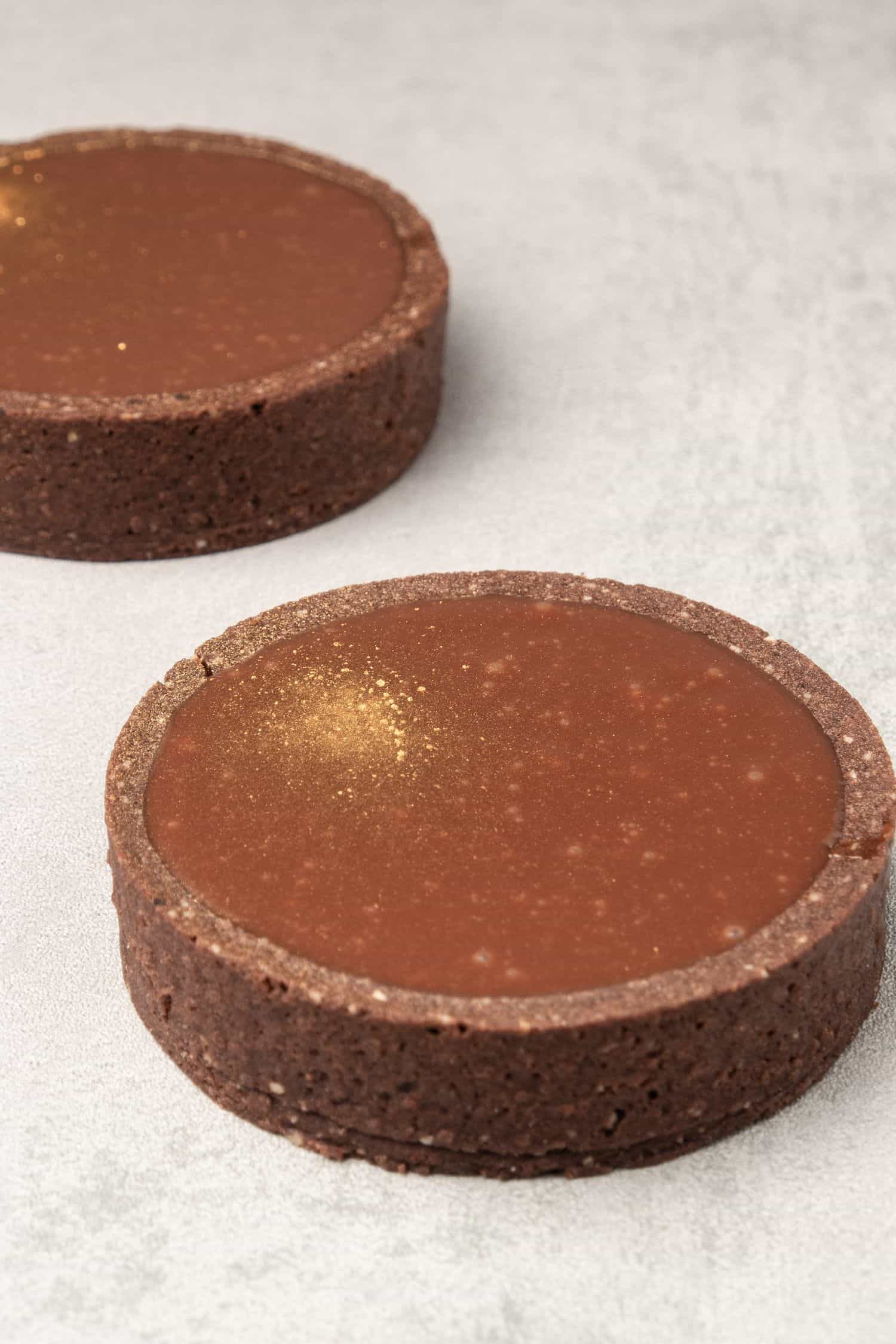

RECIPE CARD

Chocolate Pâte Sablée tart crust (VIDEO)
Equipment
- Digital scale
Ingredients
- 90 g (¾ cups) Icing sugar
- 200 g (1⅔ cups) Pastry flour
- 30 g (⅓ cups) Almond flour
- 30 g (⅓ cups) Unsweetened cocoa powder
- Pinch of salt
- 110 g (½ cups) Unsalted butter very cold
- 50 g Egg approx. 1 egg
US customary cup measurement is an indicative figure only. Measure the ingredients with a digital scale by weight (gram). Baking is art but also science which requires precision and accuracy.
Instructions
- Measure and cut butter into chunks and place it into the freezer for a few minutes
- Sift together dry ingredients; flour, cocoa powder, icing sugar, almond, salt
- Add very cold butter chunks into the dry ingredients, and rub the mixture between your hands until it becomes a sand-like consistency
- Add egg into the mixture and mix with your hands just until the dough comes together
- Knead the dough with the palm of your hand for a minute or two, just until the dough becomes smooth. Do not over-knead the dough and do not use mixer, neither a food processor
- If the dough is too warm and sticky, place it into the fridge for 10-15 minutes first. Otherwise, continue with rolling the dough out into 2mm thickness between two Silicone baking mat.
- Place the dough into the freezer for 15 min in between the two Silicone baking mat. Do not remove the mat at this point
- Prepare your oven rack with the Perforated "air" baking mat and Perforated tart rings on top
- Take the dough out from the freezer, remove the top of the silicone mat and using one of the Perforated tart rings, cut out 8 circles - this will be the bottom of your tart. Carefully move the dough circles with the help of an Offset spatula and place them into the rings one by one
- If at any point the dough gets too warm to work with, pop it back into the freezer for 5 minutes. You might need to take the dough in and out of the freezer many times depending on the temperature of your kitchen. It is extremely important to work with a dough that is cold enough to be able to handle (so not sticky) but not too cold which would result in breaking it
- Cut 8 long strips out of the dough, this will be the side of the tart
- Carefully place the strips into the ring one by one. Press each strip onto the ring so it sticks to it
- Place the Perforated tart ring with the pastry dough in them into the freezer for 1 hour
- Pre-heat oven to 160C / 320F
- After 1 hour, trim the top of the pastry with a sharp knife
- Bake for 20 min, then carefully remove the rings and bake for another 5 -10 min until golden brown. At the 20 min mark, the pastry should be already somewhat baked and therefore will contract within the ring. If the pastry feels stuck into the ring, bake it for further 1-2 minutes
- Once tart rings are removed, you will need to place the tart cases back to the oven. Bake them for another approx. 10 minutes
- Let the pastry cases cool on the Perforated "air" baking mat before filling
Notes
- Measure your ingredients with a Digital scale for accuracy
- Use high-quality 82% fat content European style very cold unsalted butter
- In case of nut allergy, almond can be replaced with an equal amount of flour
- Do not skip the salt
- Make sure you read my Expert tips section above to maximize your success. A short recipe alone is not able to cover all the necessary details, and science behind baking. Consider this recipe like an in-depth tutorial, literally the only recipe you will ever need to make chocolate tart cases
- While assembling and kneading the dough, work as quickly as possible without 1. overworking the dough 2. making the dough too warm. Kneading literally should not take more than a minute or two
- The temperature, while working with this dough, is super important. Too warm? The pastry dough will tear. Too cold? The pastry dough will break. Aim for the in-between, a cold enough dough that is comfortable to work with. Use your fridge or freezer to chill the dough if it gets too warm
- The recipe can be made with the traditional blind baking method using a tart pan, however, consider using perforated equipment for the best result
- I strongly advise using a Digital oven thermometer to be able to measure your exact oven temperature
- Check my filling suggestions

Susanne
Thankyou so much for the detailed instructions! I was always disappointed when my pastry either shrunk or puffed up. They always tasted great but the presentation was definitely lacking.
One question though. When you put the base pastry in and then the strip for the edges, do you need to use any kind of egg wash to seal them together properly? Or do you just press it together? Thanks again
Katalin Nagy
No egg wash, just press the side slightly down into the bottom and as it bakes, they will "bake together". Good luck:)
Hannah
I understand you recommend the almond flour to increase the quality of the tart shell. Do you have any recommendations for leaving out the almond flour? I'm wanting to make a nut-free version.
Katalin Nagy
Feel free to replace it with equal amount of all purpose flour.
Louise
A friend gave me little shaped tartlet pans that were her grandmothers and I want to bake in them for her. They are not perforated. Also are not flat - they are different shapes, Do you think this recipe will work? Any suggested adjustments ?
Katalin Nagy
Non perforated tart pans most likely require so called blind baking otherwise the dough will puff up. Basically you can use my pastry recipe but check my "3 ingredient pie crust" where I talk about the technique of blind baking.
Pilar
The tart turned out amazing first time tarter and it was perfect. All tips and tricks were essential. THANK YOU ALWAYS FOOL PROOF RECIPES ❤️❤️
Katalin Nagy
Thank you for your kind feedback:)
Milena
I used this recipe for a baked chocolate tart. I wasn't sure how to proceed with baking the tart shell and then baking it again with the chocolate filling. I would still like to know if I can make adjustments to ensure a delicious, crispy crust. I actually blind baked the crust and then baked it again for the recommended time with the filling inside. What would you have done?
The crust is quite tasty - not too sweet, it has a sophisticated flavor to it. It balanced out the milk chocolate filling quite well in my opinion (I topped it with a cream cheese layer and whipped cream topping).
Kata
I have a chocolate passion fruit tart that I recommend checking if you want to make a chocolate tart, it is made with the same tart shell and chocolate ganache so no second baking is needed:)
Sam
Worked a charm. I filled mine with raspberry ganache from your other recipe and it was a great combination. I still haven't invested in a perforated mat, so using a normal one I docked the bases with a fork, and added baking beads to prevent rising and this worked fine. But having followed your instructions apart from that, and these tarts turning out so nicely, I trust your advice and will do as you suggest.
Mike
Thanks for the instructions! This recipe is a keeper and works very well
Sabeel
Can we re roll the left over crust ?
admin
yes sure just pay attention to the temp as explained in the tips:)
Elaine Hindson
I had two failures with a chocolate pate sable recipe before switching to yours, and am happy to report that I was successful after following your top tips. Thanks so much!
admin
So happy to hear your feedback thanks a lot! I have tons of pate sablee on this blog, hope you will try them 🙂
Ida
How could I use this recipe for red velvet pate sablee? I want to make red velvet Creamcheese pie. Thank yoi
admin
You can replace some flour with cocoa powder and use red food coloring
Selvabella
The recipe works perfectly. Instructions are clear and provide a consistent result. Thanks for sharing
Gladys
Hello May I know how long can you keep the uncooked dough for? And also how long can I keep it for after it’s baked?
Thank you very much
Kata
You can freeze the dough both before baking and also after baking.